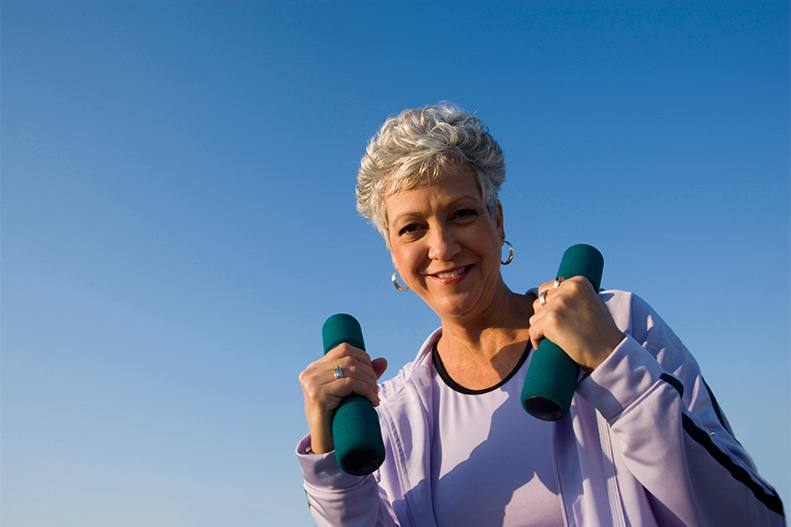A bone-weakening disorder, osteoporosis affects millions of older adults, mainly women. With this disease, your bones are thin and brittle, with lots of holes inside them like a sponge, making them easy to break, or fracture.
Fractures in the wrist, spine, and hip are commonly seen with this condition. Unfortunately, these injuries can severely impair your mobility and independence.
Never Miss a Beat!
Subscribe to Our HealthBeat Newsletter!
Thank you for subscribing!
You can now select the specific newsletters you'd like to receive.
You are already subscribed.
Subscribe to more newsletters in our email preference center.
Sorry, an error occurred. Please try again later.
Get Healthy Tips Sent to Your Phone!
Fracture Prevention
To help reduce your risk of suffering from these life-altering fractures, UPMC’s experts may recommend that you exercise. Even if you’ve already been diagnosed, exercising can help maintain the bone mass you have.
Your doctor will help you find the safest, most enjoyable exercises for you given your overall health and amount of bone loss. There are two types of exercises that are important for building and maintaining bone density:
- Weight-bearing exercises
- Muscle-strengthening exercises
Weight-Bearing Exercises for Osteoporosis
During weight-bearing exercises, your feet and legs support your body’s weight. These exercises can be high-impact or low-impact.
High-impact weight-bearing exercises help build bones and keep them strong. If you have broken a bone due to osteoporosis or are at risk of breaking a bone, you may need to avoid high-impact exercises. If you’re not sure, you should check with your doctor.
High-impact weight-bearing exercises include:
- Aerobics
- Hiking
- Jogging/running
- Jumping rope
- Stair climbing
- Tennis
Low-impact weight-bearing exercises can also help keep bones strong and are a safe alternative if you cannot do high-impact exercises. Examples include:
- Using elliptical training machines
- Using stair-step machines
- Fast walking on a treadmill or outside
Muscle-Strengthening Exercises for Osteoporosis
These exercises, also known as resistance exercises, include activities where you’re working against the weight of another object. Examples of muscle-strengthening exercises include:
- Lifting weights
- Using elastic exercise bands
- Using weight machines
- Lifting your own body weight
Yoga and Pilates can also improve strength, balance, and flexibility. However, certain positions may not be safe if you have osteoporosis. For example, exercises that have you bend forward may increase the chance of breaking a bone in the spine.
Starting a New Exercise Program
If you haven’t exercised for a while, check with your doctor before beginning a new exercise program, particularly if you know you have bone loss or osteoporosis.
Remember, weight-bearing exercise does not have to be high-impact. Running, jogging, and jumping may put stress on your spine and could lead to fractures in weakened bones. If you already have bone loss, choose low-impact activities like walking, dancing, and gardening.
If you already have osteoporosis, be careful of exercises that involve bending and twisting at the waist like sit-ups, toe touches, and rowing machines. This motion can put you at risk of fracture.
Once you have your doctor’s approval, begin slowly. As you get started, your muscles may feel sore for a day or two after you exercise. If soreness lasts longer, you may be working too hard and need to ease off.
About UPMC Orthopaedic Care
When you are dealing with bone, muscle, or joint pain, it can affect your daily life. UPMC Orthopaedic Care can help. As a national leader in advanced orthopaedic care, we diagnose and treat a full range of musculoskeletal disorders, from the acute and chronic to the common and complex. We provide access to UPMC’s vast network of support services for both surgical and nonsurgical treatments and a full continuum of care. Our multidisciplinary team of experts will work with you to develop the treatment plan that works best for you. Our care team uses the most innovative tools and techniques to provide better outcomes. We also are leaders in research and clinical trials, striving to find better ways to provide our patients care. With locations throughout our communities, you can find a provider near you.
